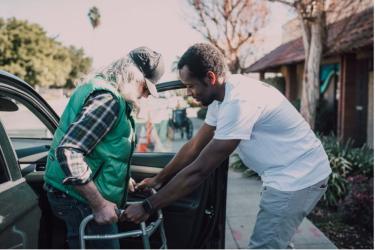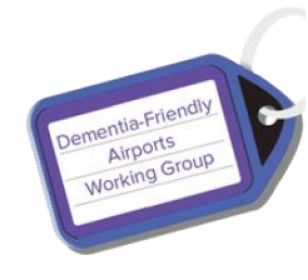
By Josie Beierl, MBWC social work practicum student
I hope that my experiences, and these compiled resources from our partners at the Alzheimer’s Association and MBWC, can help our caregiving community prepare to be “on-the-go” with their loved one and feel that they are not alone.
In this resource:
Getting Ready
Dealing with Sensory Overload
Staying Safe and Preventing Falls
Traveling by Air
“Are you ready to go Grandpa?” I ask.
“Ready, I’m always ready! Where are we going?”
“We are going to Uncle Theo’s house for dinner.”
“Theo…my son Theodore?”
“Yeah exactly! We are going to his house.”
“Why would we go to his house? He doesn’t know anything.”
“We are going to his house because it’s Christmas Eve and he invited us to have dinner with him and his family.”
“Oh, is it?” he would say as he slowly started to nod his head in approval. “Ok sure, I like him, good guy!”
Once Grandpa has gotten all settled in the car, I make sure that volume on the radio is turned down low and the heat is on because he is always cold. Before we start driving, I make sure to state, “Alright, are you ready? Let’s go to Uncle Theo’s house for Christmas Eve dinner!” I know that he will ask me why we are in the car and where we are going.
—
In 2012, my grandfather, with whom I was very close, was diagnosed with vascular dementia. Because I was in between jobs and had a nursing license, I had become one of his main caregivers. In this time, I experienced some of the joys and challenges of caregiving, which now inform my social work journey.
Here at the Memory Hub, the dementia-friendly community center run by the Memory and Brain Wellness Center and our collaborators, we often hear questions or concerns from caregivers about traveling – or just leaving the house—with a loved one. Some caregivers wonder about what they need to anticipate or whether they should travel at all because of the person's condition. Sometimes their hesitations relate to how stressful it might be for them, as the caregiver, to ensure the person is safe and comfortable in a new place.
“Travel and unfamiliar environments can be disorienting for a person living with dementia,” says our collaborator, Erica Farrell, senior care consultant for the Alzheimer’s Association and Memory Navigator at the Memory Hub. “It's important to understand that the risk of confusion and wandering increases in unfamiliar or stress-inducing situations, and that establishing a travel plan and preparing for things that may arise is essential.”
As caregivers, we know how beneficial and stimulating it can be to bring our loved ones to a new place or a familiar setting, however we have all had the same concerns and fears around how it will go and how we can prepare to keep them safe. I hope that my experiences, and these compiled resources from our partners at the Alzheimer’s Association and MBWC, can help our caregiving community prepare to be “on-the-go” with their loved one and feel that they are not alone.
Getting Ready

The first step that I always took before Grandpa and I left the house was to make sure that we had everything we needed.
I first had him use the bathroom and wash his hands. Then I made sure he had a warm jacket on and packed his hat and gloves—You never can tell what the weather will be in Seattle! Next, I went through the checklist of his medications and what times he needed to take them. If I wasn’t sure if we would be back in time for one of his medicines, I would pack it in a Ziploc bag to bring with us just in case. It was very helpful for me to have a little “to go” backpack ready for when my grandfather might leave the house. In this backpack I had an extra pair of walking shoes, a change of clothes (including socks and underwear), and a thick sweater.
My grandpa had always prided himself on looking his very best, so I knew it would be important to include a comb and hairbrush in that backpack to calm his wayward cowlicks if a hat messed up his hair. I packed floss or dental picks in the bag as well because he liked to keep his teeth clean after snacking. Spills could happen while out and about, so it was crucial to also pack a Tide to Go stick for any stained clothes and wet wipes to clean his hands. In the front smaller pocket, we packed a small first aid kit and his medications. Once I double check to make sure we have everything, it is time to let Grandpa know we’re getting in the car.
Travel considerations from the Alzheimer’s Association
- Travel to known destinations that involve as few changes in daily routine as possible.
- Travel during the time of day that is best for the person. For example, if he or she becomes tired or more agitated in the late afternoon, avoid traveling at this time.
- Always have a bag of essentials with you that includes medications, your travel itinerary, a comfortable change of clothes, water, snacks and activities.
Dealing with Sensory Overload
When driving, I would mentally prepare and warn him that we could see lots of other vehicles on the road. The number of cars, especially in shopping center parking lots, has always been overwhelming for my grandfather. At times he would be so upset that he would swear about the situation. I would then try to validate his feelings that “yes, it was crazy how many cars were out,” but also remind him that it was okay. It helped to remind him that we were not going to interact with any of them and that they were also traveling to their families’ houses. Sometimes this would help calm him.
My Grandpa experienced sundowning, or increased agitation and tiredness in the late afternoon, which is a common symptom for people living with dementia. So, I always made sure to schedule appointments or visits to family early in the day and especially when it was bright out.
Tips for a calm traveling experience from the Alzheimer’s Association
- Plan ahead.
- Learn to recognize the warning signs of anxiety and agitation and identify strategies to reduce them. Discuss this plan with the person living with dementia.
- Try not to overload the person with a lot of directions or too much information.
- Consider traveling during the person’s best time of day.
- Environmental changes can trigger wandering or confusion. Consider enrolling in a wandering response service.
Staying Safe and Preventing Falls

As my grandfather’s dementia progressed, his balance regressed, and things like getting in and out of the car became safety issues. We were able to obtain the disabled parking permit quickly through a regular follow up appointment with his primary care physician. Once the medical professional authorized the form for a disabled parking pass, the clinic mailed the application to the Department of Licensing. About two weeks later, the handicap placard arrived in the mail. It was a relief to know that we could use convenient parking spots when and if I needed to take him anywhere. Sometimes though, those spots were full. In those cases, I always tried to park in a spot that had room to completely open his car door. I knew that it was easiest to help him out of the car if we had lots of space and if he could see the path ahead of him. Usually, this was a spot at the end of a row if we got that lucky.
Once we had parked, I would tell him that I was going to come around and open the door for him. He didn’t always like that since he came from a generation that always held the door for women, but I knew I had about 15 seconds to get over to his side and help him while he muttered that he “could do this all on his own”. Once we were out of the car, I would ask him if I could hold on to his elbow, link arms with him, or put my hand behind his back. Grandpa would usually make some teasing comment about how I just wanted to be close to him. I would tell him that he was right, he was my favorite Grandpa, and I cared a lot about making sure he was safe. He liked this response and would “graciously allow me” this privilege.
I tended to talk when we were walking, pointing out things such as curbs or even the white lines in the streets. Once we got to our destination, such as the doctor’s office, I would do the best I could to get him a seat right away. I made sure to announce if we were going to have to step up on to something, or if we were just going to keep walking straight ahead on a flat surface. Yes, all this talking sometimes drove him “crazy,” as he would say. He would still get frustrated or overwhelmed with the surroundings sometimes, but at least he was prepared for his next steps.
Tips for a safe trip from the Alzheimer’s Association
- Try to avoid places that are highly congested.
- Pack necessary medications, updated medical information, emergency contacts, and copies of vital legal documents in an easy to reach place.
- Supervision is crucial, so do your best not to leave a person with dementia alone.
- Carry a bag with essentials like medications, a change of clothes, water, snacks, and engaging activities.
Further resources
- Alternative Transportation Options by Kailan Bergstrom (MBWC)
- Getting a Parking Permit Northwest ADA Center
Traveling by Air
Trips with my Grandpa almost never involved rides longer than 30 minutes. Our excursions were mostly limited to doing errands, going to the doctor, or to visit our family. But, dementia doesn’t preclude one’s ability to travel. People living with dementia, and other ‘hidden disabilities’, still have rights and deserve to have the proper support to get places safely. If you are planning a longer trip, such as a vacation that involves air travel, there many helpful resources for you to explore. Did you know there is a group of people working to bring dementia-friendly practices and protocols to airports? The Dementia-Friendly Airports Working Group (DFAWG) is an international collaboration of professionals, academics, and volunteers in aging and dementia services and support systems, including people living with dementia and their care partners. In fact, Teepa Snow, who is one of the country’s leading educators on dementia, has worked in partnership with DFAWG to improve air travel for people living with dementia and create new resources for airports and families. You can read about this effort and Teepa Snow’s 8 tips for Dementia-Friendly Airport Travel published in Alzheimer’s Today magazine.
Air Travel Resources from the Dementia-Friendly Airports Working Group
- Resources for Travel (Dementia-Friendly Airports Working Group)
- Traveling When Dementia Is Involved (A collection of teaching video clips developed by members of the Dementia-Friendly Airports Working Group and Teepa Snow’s Positive Approach to Care®, filmed in partnership with Charlotte Douglas International Airport.
Tips for Air Travel from the Alzheimer’s Association
- Contact the airline and airport about your loved one’s diagnosis and needs ahead of time.
- Inquire about airport escort services and TSA screening.
- Consider requesting a wheelchair even if the person is able to walk to have an escort around the airport.
- Consult with the person's doctor prior to airplane travel about medications that may help if the person becomes unexpectedly distressed, agitated, or anxious.
- Have the person wear an ID bracelet.
- Allow for extra time to get through security.
- Don't let your loved one wander alone.
- Remember that busy areas may be overwhelming. Consider waiting at an unused gate for departure.
- Sunflower lanyard program at Seatac
- Accessibility at Seatac
If traveling seems daunting or if travel is no longer possible, start small and give us a visit at the Memory Hub. You can bring your questions and concerns to a free consultation with the Memory Navigator at the Memory Hub. Check out all our resources and programs for caregivers and people living memory loss and dementia, such as the Shared Outdoor Adventures for Resilience Program, the Garden Discovery Program, or the Alzheimer’s Café offered here by the Frye Art Museum. And with the many Dementia-Friendly Recreation programs through Seattle Parks and Recreation, there are many ways to get physical, social, and creative stimulation without traveling very far.
